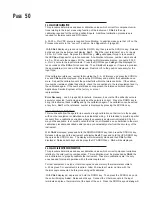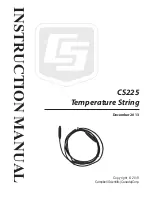
P
AGE
45
Setpoint Adjustments 4.11
Local Single Setpoint
Local single setpoint adjustment, if selected in the Program mode, is accomplished by
using the keypad. Press the UP key to increase the setpoint value. Press the DOWN key
to decrease the setpoint value. Holding the key pressed will cause the value to change
slowly at first then increasingly faster. The range of setpoint values can be limited by
selecting the desired setpoint upper limit SPuL and the setpoint lower limit SPLL values in
the Program mode. The setpoint value can be protected from inadvertent changes by
disabling the Setpoint Change, ESPC, in the Enable mode.
Local Dual Setpoint
Local dual setpoint adjustment, if selected in the Program mode, is accomplished by using
the keypad. Press the SP1/SP2 key to select either SP1 or SP2. Press the UP key to
increase the setpoint value displayed. Press the DOWN key to decrease the setpoint
value displayed. Press the SP1/SP2 key to display the alternate setpoint value. Use the
UP or DOWN key(s) as necessary to adjust the alternate setpoint value. The range of
setpoint values can be restricted by selecting the setpoint upper limit SPuL and the
setpoint lower limit SPLL values in the Program mode. Press the SP1/SP2 key to toggle
the setpoint value from SP1 to SP2 and visa versa. The Auto Tune will function at the
Setpoint 1 value. If the second setpoint is active when the AUTO TUNE key is pressed,
the key will be ignored.
Ramp Rate
A selectable Ramp Rate function can be used to limit the rate at which the setpoint used
by the control algorithm will change. This feature will also establish a soft startup. Upon
power up, the instrument will take the initial process value as the setpoint. A setpoint ramp
rate will be calculated to increase the setpoint from the initial process value to the
setpoint selected. The setpoint ramp rate feature cannot be used with the Auto Tune
function.
Sudden changes in the setpoint value entered via the keypad can be inhibited from
affecting the control outputs by use of this feature. The internal setpoint used to control
the process will ramp to the setpoint value entered at the rate of change selected.
Note: The displayed SP is not the same as the ramp SP.
FIGURE 4-3
200
201
202
203
204
205
0
5
10
Setpoint Ramp
Time in Minutes
Setpoint
in
Degrees
















































